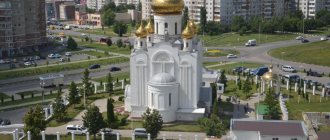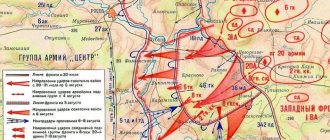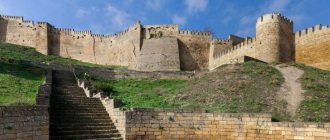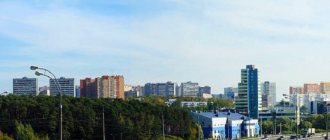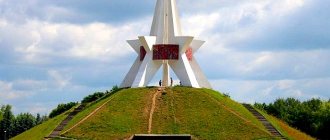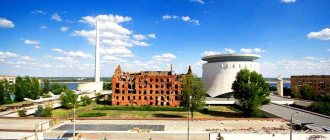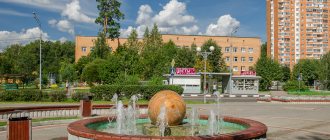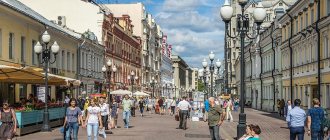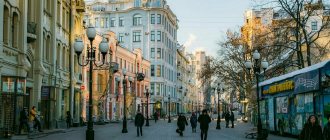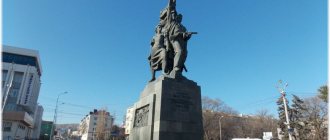I lived in Oskol for more than 30 years, but it was never able or did not want to become family to me. By the way, these are words from the hymn, there is a continuation: You are forever in my heart...
Some time ago, in the club of those wishing to move, Stary Oskol appeared at one of the top lines of the ranking of cities in which people would like to live. This fact has always surprised me. I will try to write impartially about all the pros and cons that I know of in this regional, very provincial town with a population of just over 220 thousand.
Last September, my husband and I went to live in Kislovodsk. In February I had to go to Oskol on business. A friend asked, oh, my heart probably skipped a beat when I came down to Stary Oskol land. Oh, it didn’t skip a beat, not at all. I thought, well, the weather, and the air, stinks of everything at once, and immediately pulled a scarf over her nose.
Reason No. 1, the main one, and perhaps the only one: ecology
For many, the abbreviation KMA speaks for itself. Once upon a time at school we were proudly told about the Kursk magnetic anomaly, about the richest deposits of iron ore. And we, schoolchildren of the 70s, were extremely proud of our country. And I couldn’t even imagine that fate would throw me into this iron ore region in the late 80s.
Evening Oskol
Two mining and processing plants: Stoilensky and Lebedinsky. Everyone owns a quarry. Mining, as you understand, is carried out by the cheapest method - open pit. Lebedinsky has the high title of the largest quarry in the world; it is twice included in the Guinness Book of Records. Its depth is 600 meters, maximum width is about 5 km. Reserves amount to about 3.8 billion tons. The concentration of iron in the ore is very high - from 70 percent. The Stoilensky quarry is slightly smaller, but in the next five years they are going to expand it by a third. To develop the pit, several settlements, albeit small ones, are brought under the bulldozer.
It is clear that these are not only pits in which the rock is blasted once a month. This is also a huge complex of production facilities: enrichment, pelletizing, crushing factories, etc.
In 2022, the third hot briquetted iron complex, the most powerful in the world, was put into operation at the Lebedinsky GOK. Which, as you might guess, does not ozone the air either.
For starters, there’s also the Oskol Electrometallurgical Plant, which celebrated its 45th anniversary last year. Over the years, they have produced more than 55 million tons of rolled metal and many more “by-products”.
In one of the workshops of the metallurgical plant
Of course, in recent years, enterprises have begun to monitor environmental protection. But is it possible to properly monitor such an economy?! All this power is located between the cities of Stary Oskol, Gubkin and Chernyanka.
The 2008 crisis suspended indefinitely the opening of another mining and processing plant, Prioskolsky.
A couple of little things: a cement plant, the largest in Europe. When all four furnaces are turned on, the area is covered with white frost. The ATE plant within the city and several low-power enterprises in the industrial area of Kotel pale in comparison to the giants of domestic metallurgy.
Several Oskol Bacon agricultural complexes, located ten kilometers from the city, do not improve the air. All the “fragrant” wastewater from pigs is drained into lagoons in the fields. And this question remains open, although the regional governor has met more than once with the owner of the pig-breeding complex, who swore to correct everything. And what’s interesting is that it stinks mainly in a new city and in the evenings.
From time to time, the townspeople, this time in the southwestern part, are pleased with the city Vodokanal, the reconstruction of which requires more than 2 billion rubles, which do not yet exist.
More than 60 thousand vehicles plus passing cars also do not improve the environment. That’s why the air in the city can be described in one word: it stinks.
In a residential area
The main attractions of Stary Oskol
In the evening, the alley is illuminated - a row of lanterns runs in the center. The place is popular for walks: in summer, with flower beds, the alley looks especially beautiful and solemn.
Detailed description and photo: Walk of Fame
Monument to the founders of the city
One of the symbols of Stary Oskol, a monument on the square in front of the Oktyabr cinema, was erected in 2006. The sculptural composition depicts the three founding fathers of Stary Oskol: the mayor of Ivan Myasny, the governor of Prince Ivan Solntsev-Zasekin and the clerk Mikhail Nechaev. The height of the monument including the pedestal is more than 10 meters. The creators of the sculptural composition are Ilga Gondareva and Anatoly Shishkov.
The location chosen for such an important monument is historical: it was on this square that the Oskol fortress was founded in 1593, and later the square was formed, which for centuries bore the name Red, and then Nizhnyaya, today Oktyabrskaya.
Detailed description and photo: Monument to the founders of the city of Stary Oskol
Monument to General Vatutin
Dedicated to the outstanding commander, general, hero of the Great Patriotic War, the square is located in the Central District of Stary Oskol, in front of the Trud stadium. The monument became the main attraction of the square in 1993 - on the 50th anniversary of the battles on the Kursk Bulge.
The height of the sculpture is 4 meters, the pedestal is 5 meters. General Nikolai Fedorovich Vatutin is depicted in an overcoat and with binoculars in his right hand. A memorial plaque is attached to the pedestal.
Detailed description and photo: Monument to General Vatutin
Monument to the Builders of the Railway
The full name of the remarkable monument is to the Builders of the Stary Oskol - Rzhava railway, and it is located at the intersection of 8 March - Komsomolskaya streets, on a hill clearly visible from the road. The sculptural composition is dedicated to the labor feat of women builders, who managed to lay 95 kilometers of railway track in 32 record days, which played an important role in providing troops in 1943 and the approach of Victory Day.
The monument depicts three women laying rails: two female figures are with shovels, and the third is bending over and compacting the soil. The height of the figures is 2.5 meters. The composition is complemented by rails symbolically directed into the sky.
Detailed description and photo: Monument to the Builders of the Railway
Monument to Soviet-Bulgarian Friendship
The grandiose monument, 12 meters high, is located in the northern part of Druzhby Boulevard, behind Gubkin Avenue. The creators of the monument are sculptors S. Gerasimenko and A. Buganov, architect S. Feoktistov. The monument was opened in 1979 as a symbol of friendship between the peoples of the Soviet Union and Socialist Bulgaria and as a result of cooperation in the construction of a number of objects in Stary Oskol.
Infrastructure
After a five-month absence, Oskol did not surprise with anything new. There is still the same dirt on the sidewalks, huge puddles that you can’t get around on any side, and so you just rush right through. Although no, from mid-March they are raising fares on minibuses. 22 rubles if in cash and 20 by card. On trams, conductors now issue tickets using special machines.
What am I talking about? In Kislovodsk, for example, you can only pay in cash for utilities at the RAC cash desks. Cards are not accepted here, except in large stores.
Oskol tram
The “extensive” transport network never ceases to amaze. There are many routes, but they all describe something like a figure eight, looping the northeastern and southwestern parts, connecting on Lenin Street. It is impossible to get to the Streletskaya or Lamskaya settlement or the outlying streets. They launched trial routes, but the administration considered them unprofitable.
Gumenskaya Sloboda
After the dismissal of the old mayor, Mr. Gnedykh, the new mayor, Mr. Sergienko, was given carte blanche by the governor, and an upgrade began in the city. Before this, for several decades the region gave practically nothing to the city, and it began to decline. The roads are in potholes, there is no decent park, the cultural palaces are in such a state that it’s even scary to talk about culture within their walls. We are now in our third year of renewal. Townspeople look at this differently. But mostly critically.
Curb stones along main highways have undergone a super upgrade. Although the old ones could stand for more than one year. The courtyard areas also suffered. Internal driveways were paved and children's playgrounds were taken over for parking. And the poor children were given a patch of Nif-Nif to play with.
As elsewhere, citizens voted for the improvement of public areas. The first lines on the list were occupied by the embankment of the Oskol River, destroyed to the ground by rains and winds, and the recreation area in the Zeleny Log microdistrict. In honor of its anniversary, the embankment was almost completely restored by OEMK. But the city has already invested almost 140 million rubles in Log. It was finally opened in late autumn. There they laid out flower beds, planted trees, patched up huge areas with tiles, stuck all sorts of equipment for extreme sports enthusiasts, somehow cleared the bed of the Rudka stream, and then spring came unexpectedly. And the park floated along with the flower beds and lawns. It turned out that they either forgot, or thought that it would do just fine, and did not make any drainage systems. Now they are in a hurry to decide what to do.
New square Green Log
And this is him too
Stormwater in the city is a very sensitive issue. When it rains, even if not very heavily, many roads literally go under water.
Why did I talk so much about this? Because, like everywhere else, we wanted the best, but it turned out as always. Over the three-year upgrade it is expected to spend about 15 billion rubles. This is almost three annual budgets of the Stary Oskol urban district.
The only thing that feels good are the numerous shopping centers. Year by year there are more and more of them. Just last year the Slavyanka shopping center opened, the next line of Boshe, Masquerade is building something. Just a few years ago, the amount of retail space at the norm of 550 square meters per thousand people in Oskol was twice exceeded.
Another scourge of the city is pubs in residential buildings. In our house there is one, in the neighboring one there are two. The Belgorod Duma adopted a law that pubs in multi-storey buildings will be closed if their area is less than 25 square meters. Because in such small eateries it is very difficult to maintain a drinking culture. It is clear that the first floor apartments will be converted into pubs, and there are clearly no such small ones there. This means that they will continue to flourish, and will continue to delight the residents of the surrounding houses with all kinds of aromas. There are no toilets there!
What to see in Stary Oskol and its surroundings
The central district is located between the Oskol and Oskolets rivers, where almost all the historical sites of the city are located;
The southwestern part consists of microdistricts built in the 1960s and 70s. Here is one of the oldest churches in the city - the Church of the Exaltation of the Holy Cross in the center of the former settlement of Yamskaya, as well as a cathedral - a temple in the name of the Holy Blessed Prince Alexander Nevsky;
The northeastern part is a young area of the city, characterized by modern architecture. A sports core has developed here - not far from each other are the PromAgro stadium, the Ice Palace, a golf club and a bowling club, a karting track, a tennis center, and the Alexander Nevsky Sports Palace. In the new city, as the northeastern part of Stary Oskol is also called, there are all the largest shopping, shopping and entertainment centers and the largest fair in the city - “Yubileinaya”. The bus station is located just opposite it.
Official website of the Stary Oskol district: https://oskolregion.ru
How to get there
By regular bus
A number of direct buses and minibuses depart daily from the Belgorod bus station to Stary Oskol.
Bus station: Budyonny microdistrict, 9 Telephone,
Railway connection
The railway station - the second gate of the city - is located somewhat away from the main roads (Pobeda Street), from it you can get to any area by minibus, which runs quite often. Minibuses No. 1 and 39 run to the “new city”, and No. 5 to the central and south-eastern part.
11 must-see places
All museums, most architectural monuments and many sculptural monuments are located in the central part of the city. This is where it is advisable to start the excursion.
City center
A sculpture depicting voivode Ivan Solntsev-Zasekin , city mayor Ivan Myasny and clerk Mikhailo Nechaev (sculptor Anatoly Shishkov), opens the main street of Stary Oskol - st. Lenina (formerly Kursk). Finding the starting point is easy - most passenger bus routes pass through the Lenina Street stop. And the monumental sculptural composition is located in direct visibility from the stop - about 200 meters.
Monument to the founders of the city.
To the right of the monument to the founders of Stary Oskol, goes . Volodarsky. Walk 100 m along it - and in front of you is the oldest building in the city: the former city school , the construction of which began in 1870 with donations from Stary Oskol merchants. Its architecture is truly unique and untouched by time and people. Today the Center for Technical and Youth Creativity is located here.
If you go down the street. Volodarsky towards the Oskolec River and walk along the street. Democratic, then after 200 meters you will see the former building of the Birileva girls’ gymnasium (28/1). On the right side of the monument are former shopping arcades : stone shops, which were built in 1896 by merchants Ignatov and Shurupov.
Map for walking around the center.
On the other side of the square, a two-story house of the merchant Solomentsev , also built in the 19th century, has been preserved. After the war, the third floor and columns were built; now it houses a geological exploration college.
We pass higher, to the intersection of the street. Lenin with Komsomolsky Prospekt. If you move along the avenue to the left, after about 200 meters you will see a two-story building of a former real school, built in 1907. It, like most buildings of that time, is distinguished by perfectly preserved brickwork, delicately made stone window frames, brick turrets and cornices. And if you turn right at the intersection, then after 50 m, on Komsomolsky Prospekt, you will see the former branch of the Russian-Asian Bank (Komsomolskaya St., 57), one of the large banks of pre-Soviet Russia, built in 1896. Its turnover reached 95 million rubles. Behind it is the building of the former City Duma, decorated with an openwork wrought-iron balcony made by famous blacksmiths - the Lanin brothers. Of all the masterpieces of the famous blacksmiths, very few have survived to this day: the decoration of the balcony on Volchinsky’s house, located just above the intersection, and the fence and gate of the Holy Trinity Church in the former Streletskaya Sloboda.
Holy Trinity Church
st. Bolshevikskaya, 17/15 (4725) 22-14-29 https://troiz-hram.nichost.ru
One of the oldest surviving churches in Stary Oskol. Built in 1730 in the center of the Streletskaya settlement. It was erected in different architectural eras: the main building was from the Baroque period, and the extensions were from late classicism. The church is located at the intersection of the street. Bolshevik and Kolkhoznaya, from the east there is a small cemetery of the 18th century adjoining it.
Holy Trinity Church.
Military Glory Park
Immediately behind the City Duma, a monument to Alexander Nevsky (installed in 2010, sculptor Anatoly Shishkov) - the heavenly patron of Stary Oskol. The monument is part of the ensemble of the Park of Military Glory, where there is also a memorial sign to the victims of fascism “Grieving Mother” (installed in 1985, the authors are Stary Oskol artists Valery Golyshev and Pavel Shlyapnikov), at the foot of which the Eternal Flame burns.
Monument to Alexander Nevsky. Photo by Vitaly Garkusha
Stary Oskol Local Lore Museum
st. Lenina, 50 Phone https://sokm.org.ru Opening hours: daily from 10:00 to 18:00, except Mondays
The museum is located in a house that before the revolution belonged to the wealthy merchant Likhushin . This place was considered very prestigious. There was a struggle for the right to build a house here between the merchants Likhushin and Kobzev. Likhushin won. In 1880, he ordered a house design from a French company and began construction. And soon one of the most beautiful buildings appears in the city: two balconies - “swallow’s nests”, a bell tower in bronze tiles shines in the sun. A windmill spins on the spire - a “golden harp” - a musical box with melodies.
Stary Oskol Local Lore Museum. Photo by Vladimir Babich
Stary Oskol Art Museum
st. Lenina, 57 Phones: (4725) 22-191-8 and 22-63-78 https://www.museum.ru/M1462
Opening hours: daily from 10:00 to 18:00, weekends - Sunday, Monday Ticket prices: adults - 23 rubles, children, schoolchildren - 11 rubles, with a guided tour - 17 rubles.
Cathedral of the Holy Blessed Prince Alexander Nevsky
st. Tokareva, 4/1 Phone
Located in the former settlement of Gumny. It was erected in 1903-1908, in the era of eclecticism using elements of ancient Russian architecture. The consecration of the temple in honor of the holy noble prince Alexander Nevsky is associated with the salvation of the family of Emperor Alexander III during the crash of the royal train on October 30, 1886 near the Borki station. This event was marked by the construction of a number of churches and monasteries throughout the Russian Empire, many of which were built in honor of St. Alexander Nevsky, the emperor's heavenly patron.
Cathedral of the Holy Blessed Prince Alexander Nevsky
Square of victory
The walking area in the Zhukov microdistrict always attracts the attention of city guests. It is especially beautiful and cozy here in the summer: artistic fountains, man-made ponds, figures made from living ornamental shrubs. The walking area is crowned by Victory Square, on which is installed the “City of Military Glory” stele, a monument to Marshal Georgy Zhukov, and the Walk of Fame with busts of Stary Oskol residents - Heroes of the Soviet Union. Not long ago, the composition “After the Battle” appeared on the square in honor of a simple Russian soldier. This is a so-called contact sculpture - you can sit next to the bronze soldier and take a photo as a souvenir.
Square of victory. Photo by Vladimir Babich
Stoilensky mining and processing plant.
southwestern industrial district, Fabrichnaya site, proezd 4 Telephone Time and cost of the excursion: by agreement with the management of the mining and processing plant Website: www.sgok.ru
Stoilensky GOK is one of the leaders in the production of raw materials for ferrous metallurgy. The depth of the quarry reaches 370 m - the landscape is impressive, as is the equipment working in this section of the Kursk Magnetic Anomaly: for example, a walking excavator 52 m high and weighing 3,500 tons. Read more about what you can learn on the excursion in the special section of the Travel Bureau about industrial tourism.
Stoilensky GOK
House-Museum of V. Ya. Eroshenko
st. Eroshenko, 15 Phone https://eroshenko.org.ru
Opening hours: from 9:00 to 17:30, closed on Monday
In the village of Obukhovka, a blind writer, teacher, Esperantist Vasily Yakovlevich Eroshenko was born. He became a living legend for blind people not only in Russia, but also abroad. Yeroshenko lived a colorful life. A tireless traveler, he knew 12 foreign languages and was a professor at Tokyo and Beijing universities, and became a classic of Japanese children's literature. In the house where the great man was born and died, today there is a museum.
House-Museum of V. Ya. Eroshenko
Stary Oskol Zoo
Telephone Opening hours: from 10:00 to 17:00 - in winter, from 10:00 to 19:00 - in summer, without breaks and weekends
Ticket price: for adults – 150 rubles, for children – 50 rubles
The zoo is located near the Chumaki farm . You can get there by buses No. 110 and 333 (it’s convenient to get on at the Stroitelnaya stop), which will also take you to another beautiful place - the Stary Oskol Arboretum, located a little further, on the Ilyina farm.
The zoo is home to about 90 species of animals: Indian elephant, Amur tiger, leopards, lions, lynxes, brown, Himalayan and even polar bears, sika deer, bison, yaks, camels, chimpanzees, pelicans, peacocks, ostriches and pheasants. By the way, the zoo owes its birth to them, as it appeared on the site of a pheasant farm.
Photo by Vitaly Garkusha
Arboretum
Ilyina Farm You can get there by buses No. 110 and 333 from the Stroitelnaya stop in Stary Oskol
In the arboretum you will find yourself in a real green paradise. More than 70 species of various trees and shrubs grow here, including those exotic for the area, and more than 60 species of flowers and herbs grow. The paths along its territory are made from tree cuts. An open classroom has been created to conduct school lessons in nature. An ecological trail “The Eighth Wonder of the World” has been laid, 800 m long, with eight thematic stops.
Arboretum
To book an excursion, you must first contact the Children's Ecological and Biological Center by calling (4725) 22-79-38.
Entrance to the territory of the arboretum is free, without breaks and weekends.
About medicine
Medicine is lame, like everywhere else. Paid please. And MRI and ultrasound, and any tests. And so are private medical centers. I am especially pleased with the next innovation of the medical authorities. To get to a specialist doctor, you must first visit a therapist and only he has the right to make an appointment for you. For example, a meeting with a rheumatologist took place a month later. No specialists.
Two city clinics for adults and one for children also suffered the fate of an upgrade. Even the facades were updated, the walls inside were painted a pleasant light shade (how long will it last). Although the regional authorities are trying to attract young specialists with all sorts of programs like “Zemsky Doctor”, increasing wages for medical personnel, and building first aid stations in villages, this is not working yet.
Education
The problem with kindergartens seems to have been solved. They built several in the nearby villages of Peschanka and Lapygino, a couple in the city, equipped to the last squeak. In the most expensive (in terms of housing) microdistrict Stepnoy, they promise to open a school on September 1.
There are enough schools in the area. At first glance, there are no problems with secondary and higher educational institutions either. Geological Prospecting Institute, several technical colleges, a branch of Belgorod University, which mainly trains teachers and educators in kindergartens. There are a couple of Voronezh universities: VEPI (which is always deprived of its license for various specialties), VSU, but the education there, according to students, is so-so, but they issue an ordinary diploma.
Geological Prospecting Institute
The tower's flagship is MISiS. There are a lot of specialties, from economists to metallurgists. But those who can and want to get a good education leave for Moscow, St. Petersburg, Voronezh and Belgorod. Although the latter lost ground a lot. There is usually nowhere to work after graduating from university, unless, of course, there is a connection or you have seven spans in your forehead.
My husband has a friend. An ordinary family, wife and two sons. I won’t say that they studied better than anyone else at school, but they didn’t enroll in Stary Oskol. The eldest went to Belgorod to study as an architect. But from there, after a couple of years, he transferred to St. Petersburg. The younger one went to Voronezh for science and is studying foreign languages. They themselves come from Kazakhstan. We bought a house in a cottage community, he never found a job in his specialty, his wife got a job as a dispatcher in a company and that was all. The house was completed for several years, but there were still not enough relics. A year ago we rushed to Voronezh, rented an apartment, he drove a taxi, his wife worked as an administrator in a shopping center. He is not going home to Oskol. He put his unfinished cottage up for sale. But so far no one is giving a good price.
About work
Work is hard. No, if you take more and throw it further, you can get settled. But, again, it depends where. If, for example, it’s difficult to get into OEMK or GOK. My former employee was able to find a job as a simple electrician on Stoilensky through tenths of hands. At large enterprises there is a waiting list of children of employees. As you understand, office workers have their own turn, and workers have theirs.
Salaries are also not very encouraging. Just recently, metallurgists became a little indignant, and their wages were raised by 11 percent. The main workshops receive from 40 to 60 thousand, auxiliary from 25. At the plant, the average salary is about 100 thousand rubles, but this is like the average temperature in a hospital. The management there doesn’t complain, just like everywhere else.
Small and medium-sized businesses don’t pay much either. In trading you can’t scrape together more than 20-25. There are plenty of vacancies on the labor exchange, but there are not enough people willing to work for pennies.
The city is, by and large, just a residential area, living in two shifts. Almost all enterprises have a continuous cycle and therefore always work without a break on weekends and holidays.
City center - crossroads on Lenin
About leisure
There is especially nowhere for young people to relax. In large shopping centers, certain islands of entertainment have been created: bowling alleys, trampolines, game rooms, all sorts of dinosaurs, cafes for every taste and budget. But it gets boring.
Donosaurus - in front of the dinosauria of the Boshe shopping center
Would you like to play sports, please? Several swimming pools, an ice skating rink, workout grounds, football fields, an indoor shady court.
There are a couple of museums with old, dusty curtains. The local theater was recently restored. The artistic director is trying his best to turn Stary Oskol into a city of theatergoers, but I don’t think he succeeds.
Thanks to the efforts of ex-mayor Pavel Shishkin, a real zoo appeared in the city. There is even a real giraffe, a huge lion, several rhinoceroses and a bunch of other exotic creatures living there. In the summer, many people go there with their children; it’s really interesting there.
Celebrity of the Stary Oskol Zoo - Josephine
"Window to the Past"
This is the name of a unique exhibition telling about a small district town in the Russian province, which works in the Stary Oskol Local History Museum.
In the exposition of this exhibition, according to the idea of the museum workers, the appearance of Stary Oskol from the late 19th - early 20th centuries was recreated:
“Cities are open-air museums. Each has its own unique history, which can be traced even in the names of the streets...”
The idea for the entire exhibition was formed by a series of photographs made by superimposing ancient photographs with modern views. The author of the photographs, one of the organizers of the exhibition, member of the Museum Council, Vladimir Grigorievich Churikov, has always been interested in the history of his native land. The family talked about a lot of things. Friends, relatives and ordinary townspeople brought him old photographs, which were partially retaken.
Vladimir Grigorievich Churikov.
Vladimir Grigorievich conducted numerous inquiries, carefully peering at the views of the city at the turn of the century. For a long time he dreamed: it would be great to recreate the appearance of antiquity, so that contemporaries could clearly see what Stary Oskol looked like before the Great Patriotic War. That’s why the idea came up: if you take pictures from the same point from which the old photograph was taken, everything will work out!
The bell tower of the Holy Cross Church in the Yamskaya settlement was chosen as such a reference point. And the photo was taken in January 2010 with the blessing of Fr. Alexandra, we had to climb to the second tier of the building! There was no doubt - an old photograph can easily be superimposed on a modern panorama. This is how the series of collages of the same name “Window to the Past” was born. Now for the first time we can see where and how the Assumption Church, Mikhailovskaya and Akhtyrskaya, which were blown up and looted in the 30s, were located, what the main street (now Lenin) looked like from Nizhnyaya (Red, Sovetskaya, Oktyabrskaya) square upwards, what historical buildings were lost, and which ones still form the basis of the streets, however, often with facades that have already been changed, rebuilt and re-plastered... In ancient photographs - the Epiphany Cathedral, the Kazan-Nicholas Church, the shopping arcades of the merchants Ignatovs and Shurupovs... Some photographs quite give an idea of the silhouette of the city in those distant years.
Ancient shopping arcades. Photo: “Window to the Past” series, author Vladimir Churikov.
I think many Oskol residents who are interested in the culture and history of the city and district are already quite tired of the popular popular-craft Stary Oskol. Here, in two exhibition halls of the local history museum, a completely different Oskol awaits us - real and at the same time poetic, quite material, textured, tangible, but somehow literary-figurative, lyrical. Here you will plunge into the life of a merchant, feel the breath of the Silver Age, remember pre-revolutionary melodies, looking at the old gramophone, think for a moment that once upon a time your grandmother had just such a dress, in which, perhaps, she danced at the prom, and the teddy bear is probably still collecting dust in the attic somewhere.
Stary Oskol - real and poetic...
Numerous household items of the townspeople, haberdashery goods, perfumes, a collection of fabrics from the mid-twentieth century, documents, letters, banknotes, interesting group photographs and portraits of residents from the museum’s collections organically accompany the collages.
Three paintings, recreated from documents and old photographs, by a member of the Union of Artists of Russia Alexander Filippov, donated to the museum by the author, are located in the first hall and give us an idea of the picturesque views of Stary Oskol at the turn of the century, echoing a large historical photo panel.
Alexander Filippov. Stary Oskol at the turn of the century.
In pre-revolutionary Russia, the church played a large role in the public life of the state; records were made in church parish books. The display cases display documents, birth certificates, birth certificates, marriage certificates, replacement passports and information about the deceased for the year. The list of exhibits includes a Bible from 1899, an Iveron Icon of the Mother of God in a frame, and a 19th-century Feodorovskaya Icon of the Mother of God, found in an old house in the village of Kunye, Kursk region. And here is the children's game "Bilboke" from the late 19th century: "A toy consisting of a ball and a wooden cup on a rod, into which the ball is caught by tossing it." Our great-grandfathers and great-grandmothers played the parlor game “Flirting Flowers.” There are numerous items of women's clothing, including Vera Dankova's towel from the early 20th century, a sewing machine, a kerosene lamp, ceramic beer jugs, and beer bottles from the merchant Dyatlov's factory. It turns out there were three breweries in the city.
Beer jugs.
The story of industrial Oskol is clearly visible in the windows, and almost all production in those years was mainly concentrated in the hands of merchants. I would like to note a magnificent photo of the merchant Likhushin’s creamery - the picture shows not just a building, but a whole composition unfolding here, with workers and employees visible in the foreground. The staged group photos are unique: the family of the priest of the Holy Trinity Church Babakov at the beginning of the century, the family of Pavlov, the director of the Higher Primary School, a leisurely tea party in a merchant family dated 1905. Some old-timers still remember what the particularly distinctive house of the merchant Mikhail Kobzev, built for his daughter, looked like - carved, wooden, with turrets and balconies, this house could be seen from afar. People called the house “Margarita’s whim.” The mansion was designed by Nadezhda Voeykova, whose mysterious architecture reflected her extraordinary abilities and talent in wood carving. The flower of the city's youth gathered here. The music of Tchaikovsky, Glinka, Rachmaninov sounded from the open windows of the mansion...
House of merchant Mikhail Kobzev. Photo: “Window to the Past” series, author Vladimir Churikov.
The next showcases of the exhibition are filled with objects that were in use in the 50s, 60s, and 70s of the twentieth century. A wall clock with a pendulum sits next to a wooden first aid kit. The first Soviet TV “Record” has found its niche, and you will also see a tribute to the fashion for decorating your home with porcelain figurines.
Household items of the 50s, 60s, 70s of the twentieth century.
The museum workers managed to recreate the special integrity and smoothness of the narrative in the exhibition. Thanks to their skills, the history of the county town is perceived easily and will be remembered for a long time.
